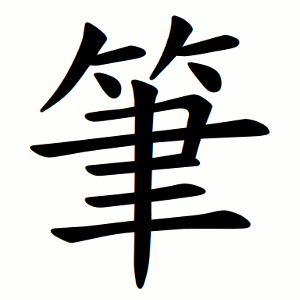筆
- writing brush;
- pen;
Any instrument used for writing or drawing.
Etymology
A phono-semantic compound composed of:
竹 (bamboo, 죽) — semantic element, indicating that the writing brush shaft was made of bamboo.
聿 (brush-handle / to write) — phonetic and partially semantic component, representing the brush itself.
Together they convey “a bamboo-handled brush used for writing.”
This structure reflects the brush’s original form — a bamboo stick tipped with animal hair, bound and shaped to hold ink.
Usage in Korean
글을 쓰다 / 필서 (筆書) — to write with a brush or pen
필적(筆跡) — handwriting; brushwork
필자(筆者) — writer, author (“the brush-holder”)
In classical usage, 筆 symbolized literary skill and scholarly virtue, much like “the pen” in Western idiom (“the pen is mightier than the sword”).
Words that derived from 筆
Additional notes
In East Asia, 筆 (the brush) stands as one of the Four Treasures of the Study (文房四寶) — 筆 (brush), 墨 (ink), 紙 (paper), 硯 (inkstone) — the essential instruments of classical scholarship and art.
筆墨之道 (the Way of Brush and Ink): represents moral discipline and artistic cultivation.
The movement of the brush was seen as a reflection of one’s mind and virtue — fluid yet controlled.
To “hold the brush upright (正筆)” symbolized righteous conduct.
In both Confucian and artistic contexts, 筆 embodies intellect, integrity, and creative expression.
Calligraphers viewed brushwork (筆法) as a mirror of the soul, where each stroke revealed the writer’s inner rhythm and sincerity.
Linguistic notes:
The Korean word “붓 (but)” — though now regarded as a native word — is believed to derive from *Old Chinese 筆 (p.[r]ut) through early cultural contact, showing how deep the brush tradition penetrated the Korean language long before recorded history.
This makes “붓” one of the oldest Sino-Korean borrowings, likely predating even the Three Kingdoms period.
